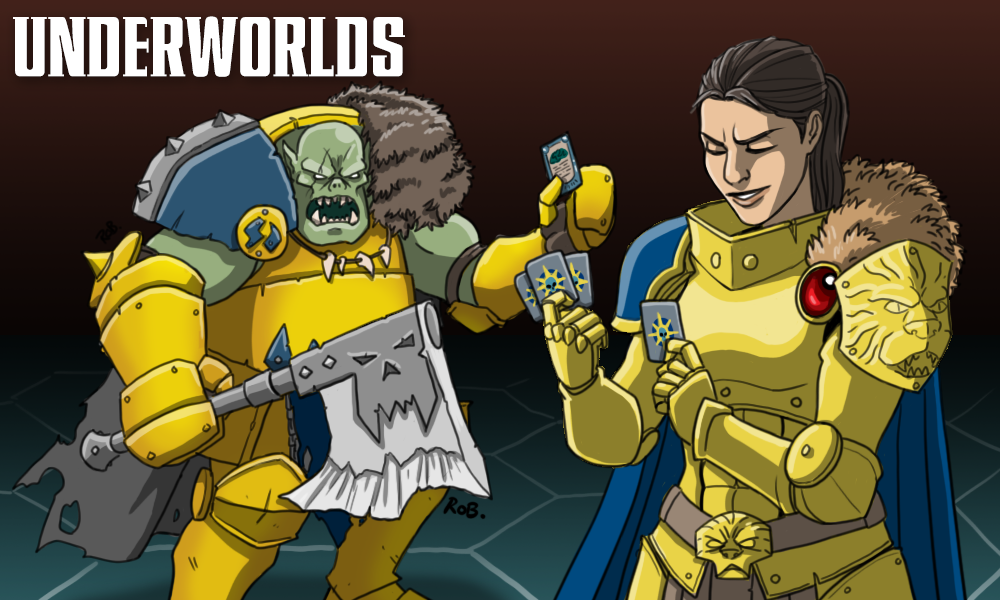If you’ve missed our previous coverage on Warhammer Underworlds, check out an overview on why you should be playing it and our review of Beastgrave, the new Starter Set.
Warhammer Underworlds is unique among Games Workshop’s other offerings – and other games across the industry – in that it combines tactical miniature combat with Deck Construction. If you’ve never played Magic: The Gathering, Android: Netrunner, or any of the other myriad card games out there you may be unfamiliar with this concept; I’m here to help. Deck Construction refers to games that require you to Construct a Deck of cards before you start playing the game. This deck (or decks in our case) are brought to your match and will greatly influence how well you perform. Success in any game with an element of Deck Construction requires skill in the playing of the game but also in the pregame element of construction.
This article aims to help you understand where to start and how to begin constructing a deck for Warhammer Underworlds. It is not intended to help you build a meta-smashing, tournament winning deck. That will come later. For now, let’s get through the basics. There are 4 card types in Underworlds: Objectives, Upgrades, Ploys, and Spells. Ploys are Spells are both also categorized as Gambits.
What Do You Need?
The first step of any deck construction game is understanding what your constraints are. Some of them are enforced by the game and/or event you’re attending. In Warhammer Underworlds there are a few universal rules that must always be followed:
- You must construct 2 decks: an Objective Deck and a Power Deck
- Objective Decks must include exactly 12 Objective Cards.
- Power Decks must include at least 20 cards and no more than half can be Gambits.
- You can only use Universal Cards or cards with a faction symbol matching your chosen faction (faction cards)
- You can’t add any duplicate cards (by name) to a deck. Each card must be unique.
Additionally, a tournament or event may impose additional rules. Games Workshop has a couple of event types with special rules. For the purposes of this article, we’ll focus on the Championship rules. In addition to the universal rules, these are
- No cards from the Banned list may be included in any deck.
- Only 3 cards total may be chosen from the Restricted List. This applies across both decks (i.e. you can’t have 5 Restricted Objectives and 5 Restricted Power cards) – This reflects a 10/17/2019 update
- Only 6 Surge or “score immediately” cards may be included in your Objective Deck. These objectives allow you to score points mid-round and draw a new Objective card, making them very powerful.
Those are the only formal constraints. Other constraints are dictated more by strategy. For example, you don’t want to include any spells or spell-based objectives if your warband has no wizards!
Getting Started
The first thing you’ll want to do is choose your warband. There are currently 21 warbands available to choose from and all play a little differently. Your deck and your fighters should work in concert, each supporting the other with the goal of scoring as much glory as possible. Let’s take a look at one of my favorite warbands: Ylthari’s Guardians. They are Sylvaneth warriors who offer decent move and attack stats, and aren’t too tricky to learn to use. Before I start working on decks, I always take an extra minute to examine my fighters and their faction cards.
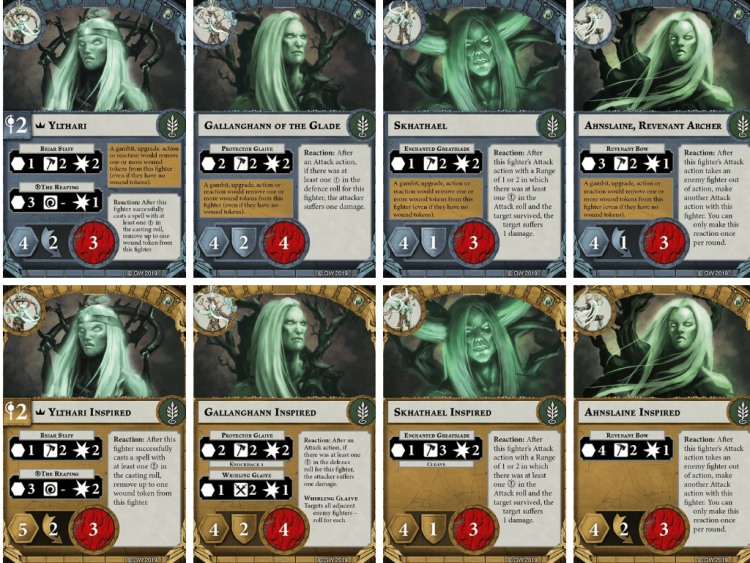
All warbands in Underworlds have a condition by which they Inspire, becoming more powerful. Ylthari’s Guardians all inspire in the same way (a wound token is removed from the fighter) though each changes in different ways. Exactly how they change isn’t important right now, but generally speaking inspiring your warband is something you’ll want to do. The benefits can mean the difference between victory and defeat. The other thing to note is that all 4 fighters have a Reaction ability printed on their card. Reaction abilities allow you to break the normal flow of the game, inserting an action in response to an event. In the case of the Guardians, three of them are dependent on rolling a Critical Success on an attack, defense, or spell roll.
Now we can take a look at the faction cards, paying special attention to the faction objectives. Broadly speaking, faction objectives are cards that your warband should be pretty good at scoring and offer a great starting point. If your faction doesn’t have any objectives associated with holding Objective Tiles on the board, it’s likely a fair assumption that holding territory isn’t one of your faction’s strengths. The official Games Workshop Deck Builder is a great option, especially for those who like to see the cards themselves while building a deck. For readability purposes, all of my screenshots are going to come from UnderworldsDB.com, another excellent site. I recommend you follow along with one of these sites, as it will make understanding the article easier!
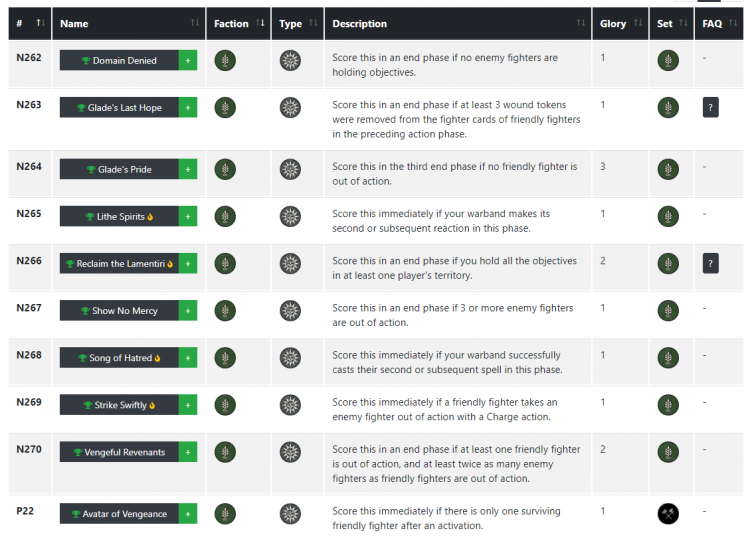
Ylthari’s Guardians are a fairly balanced faction. There are a couple Objectives related to killing enemies, a couple related to the Objective Tiles on the board, and even one that helps if your fighters are the ones getting murdered. Because we took the time to review our fighters, a few cards stand out. Glade’s Last Hope, and Lithe Spirits look like natural fits given that we’re going to want to heal our fighters anyway and because they all have Reactions. Song of Hatred also seems to work well here; Ylthari has a built in Spell Attack we’ll likely be casting. If it triggers her Reaction and removes a wound token then it helps score Glade’s Last Hope and Lithe Spirits as well! Identifying synergies like that is key to building a good deck. Let’s throw Glade’s Pride in there as well; if we’re going to be healing ourselves as much as we can maybe we stand a chance of surviving unscathed.
Now, let’s take a look at the Gambit cards. These are Ploys and Spells primarily played in between fighter activations. They’re special powers or abilities that can dramatically reshape the battle field as you take extra actions, give your fighters temporary boosts, or impede your opponent. With hundreds of cards to choose from it can be overwhelming so again let’s start with our faction cards, specifically the Ploys.
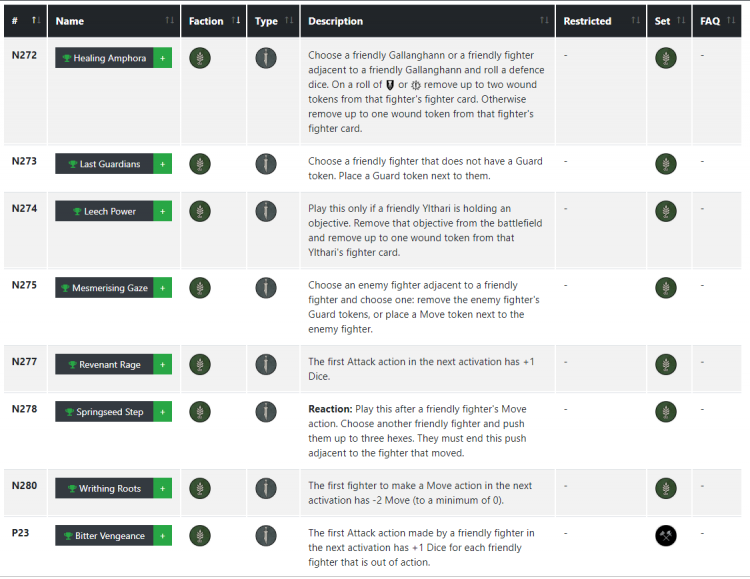
A-ha! Right at the top of the list is a card that will Inspire Gallanghan or an adjacent friendly fighter. Healing Amphora feels like a no-brainer given our desire to Remove Woiund Tokens. Leech Power also offers us the opportunity to Inspire Ylthari just in case our rolls aren’t helping us on the spell casting front. It also removes an Objective Marker which is interesting; that makes Domain Denied and Reclaim the Lamentiri easier to score. We can go back and add those to our deck as well.
With those in our Objective Deck I’m going to go ahead and add Last Guardians to our Power Deck. Guard is always useful, especially since we have a few fighters who only defend on Dodge symbols. Additionally, with the change in Beastgrave preventing fighters with Guard tokens from being driven back it also makes holding objectives easier. Finally I’m going to add Revenant Rage and Bitter Vengeance to our Power deck – extra Attack dice will make Ylthari’s spell attack and Skhathea’s attacks more likely to roll a Critical Success, triggering a Reaction and helping score our objectives. Because extra Attack dice are always useful, it will never be a dead card. This is something else to be on the look out for: try not to include cards that have specific uses that may not come up or are only useful as part of a specific combo you may not be able to pull off. Now let’s move to the Spells.

For now, I’m putting all of these in! They unfortunately won’t help us out on the healing front nor will they help with the objectives. However, Ylthari wants to be casting spells for Lithe Spirits and Song of Hatred anyway and its important to not get so focused on our Objectives we forget that there will be snarling Skaven, boorish Beastmen, or cursed Chainrasps trying to stop us the whole time. Now we’re on to the Upgrades.
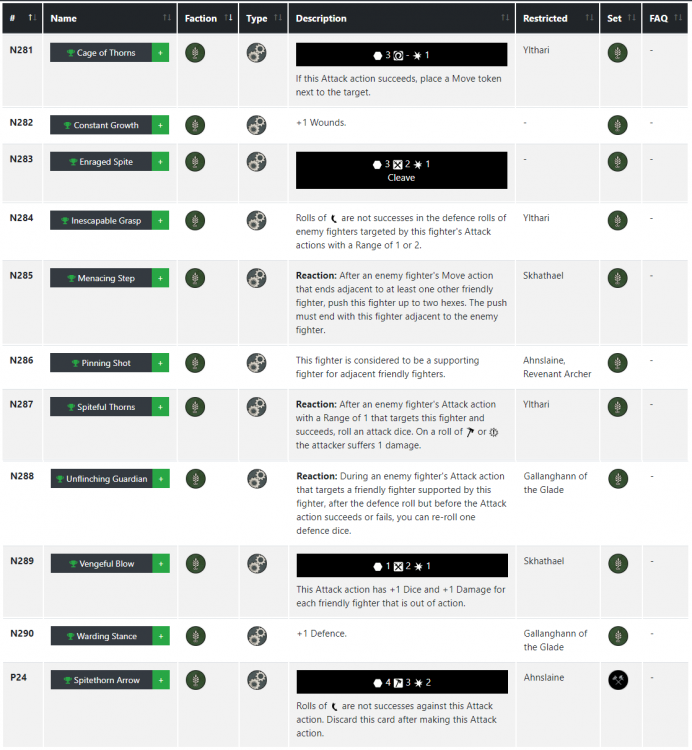
Things get a little trickier here. Many Upgrades can only be applied by certain fighters, making their addition risky. If that fighter dies it’s a dead card. Additionally, none of these help us with our Healing objective. That isn’t surprising; because Upgrades are permanent improvements to your fighters they’re often more of an indirect help. A good example of this is Constant Growth. It doesn’t directly help our goals but it is very useful for a variety of reasons. For one, extra wounds are always great – being harder to kill is a good thing. In our specific case, however, it will provide a few additional benefits. An extra wound makes it harder to be killed in a single shot so you actually have a wound to remove. It will also make us more likely to have all of our fighters survive battle. Warding Stance is going in for the same reason.
Menacing Step, Spiteful Thorns, and Unflinching Guardian are all going in for the Reaction abilities. Pinning Shot as well. It’s useful, and will come in handy for reasons I’ll get to in a future article. I’ll encourage you to test this deck if you can, so see if its inclusion makes sense.
At this point, we’re done with the initial review of our Faction Cards. We’ve got a solid starting point with a few clear themes. We’re going to be aggressive with spells and board control. Ideally, we survive through the whole battle leveraging health gains and the ability to heal scoring points along the way. As we look to the Universals, we’re going to want to supplement these themes. I always do this as a first step to building a deck especially if I’ve never used that warband.
Fleshing Things Out
The next step is to finish out our decks using Universal Cards. This gets harder, because there are a lot of Universal cards to go through. Remember that the key here is to focus on our themes for the deck and the objectives we already have. The goal of this stage is to see if we can find Universal Cards that will help us do what we already plan to do, or let us double dip on scoring. I know I want to max out possible Surge Objectives so I’m going to find at least 4 more.
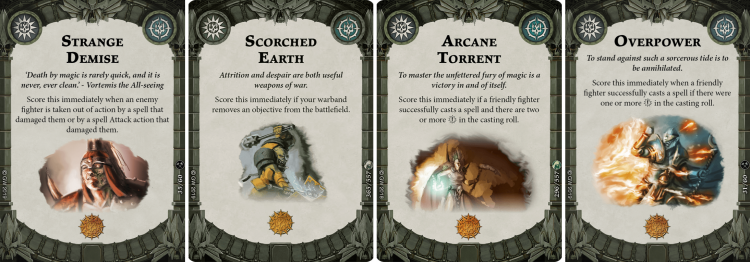
I’m going to go with Strange Demise, Scorched Earth, Arcane Torrent, and Overpower. Hopefully by now you can see why I’ve included these. We’re already committing to casting lots of spells with Ylthari and adding dice to her attacks. That makes 3 of these easier to score. Scorched Earth breaks my rule about combos, but it gives Leech Power an additional use so we’ll stick with it.
We still need 1 more objective, and I’ll go with Magical Storm which requires that I cast 4 spells. I’m really leaning into magic which may be risky, but this exercise is about following through on themes and seeing how the deck work. Ylthari is going to be very important to our strategy, so I’m going to focus on keeping her alive.

If we’re doing spells, let’s do spells. Both of these are easy to cast and they have the benefit of being Reactions. I’m double dipping again – this helps score our spell objectives, reaction objectives, and gives Ylthari even more opportunities to Inspire.
Finally we need 4 more Upgrades. Great Fortitude (+1 Wounds) is an easy card to add to any untested deck. It will gives us yet another way to beef up our fighters and make them survivable; my goal will be to put it on Ylthari. Challenge Seeker gives us +1 Dice on an attack when targeting a fighter with a higher Wounds characteristic. This is good for Skhatheal in certain matchups and reinforces a few objectives. Arcane Focus and Arcane Savant will round out our objectives by making Ylthari even better at casting. At this point you can check out the completed deck by following this link.
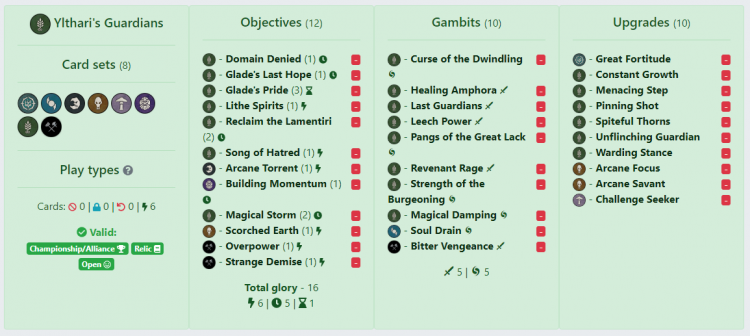
The last step is to go play with the deck! All the theory crafting in the world means nothing until you see how the deck performs. I have some concerns regarding putting all our eggs in one basket, but this deck accomplishes the goals I set out with. It has a clear focus, it explores the strengths of the warband, and any combos or dependencies are mitigated with redundancy. I’ll come back with another article soon exploring how to fine-tune a deck after testing.
Deck Building 201 has been published. You can find that article here; it reflects on this article following testing and retunes the deck to make it stronger!
